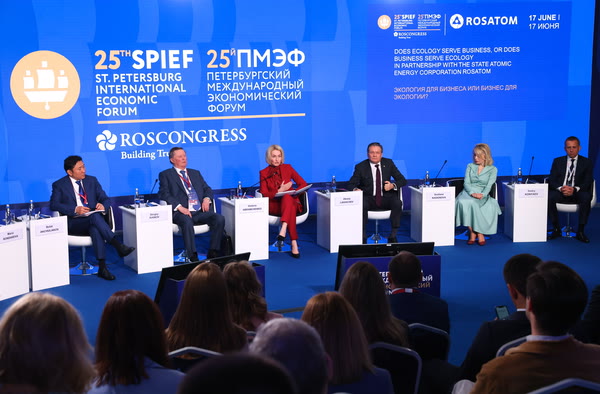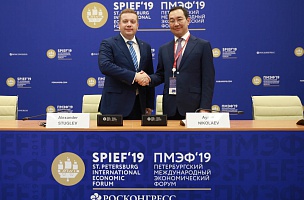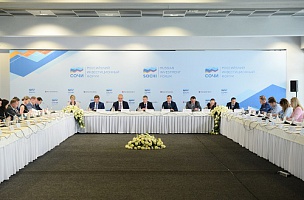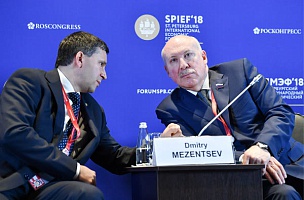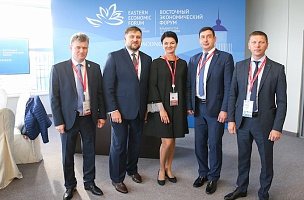KEY CONCLUSIONS
Government and Business Must Work Together on Environmental Issues
“Businesses are always saying that they need the best available technology. [...] Financing should, of course, be mostly private. [...] The carrot and stick, including fines for those who are unwilling or unable to meet environmental standards. The government needs to work it out,” Sergei Ivanov, Special Representative of the President of the Russian Federation on Environmental Protection, Ecology and Transport.
“For us, ecology is, of course, a business. We are not a charitable organization; we are obliged to keep our eyes on the numbers. But we are serving others, too, which is why Rosatom was created in the first place,” Alexey Likhachev, Director General, State Atomic Energy Corporation ROSATOM.
“I believe that the Russian business community is, for the most part, environmentally responsible. It’s a trend that needs to continue. It’s impossible to travel this road alone. In general, I think that our Cabinet’s greatest achievement is the way we’ve changed our attitude towards the environment. Over the past two years, we’ve managed to stop treating the environment like a poor relative who is constantly trying to borrow money. […] It’s a two-way street - on the part of business, and people, and the state,” Victoria Abramchenko, Deputy Prime Minister of the Russian Federation.
It Will Take Decades to Eliminate All the Waste that’s Pilled up Around the World
“Young people have a different attitude towards the environment. I’ve been watching the change for the last 5–6 years. You’ve probably also noticed how young people get out there to clean up the spaces around us – from parks and public gardens to the Arctic, where they’ll be working for decades to clean up what the Soviets left behind. […] I’m not blaming the Soviet Union – they didn’t have the technology at the time. You could only take barrels of fuel oil up to the north and leave them there for decades. There were no floating nuclear power plants back then. And now there are, thanks to Rosatom,” Sergei Ivanov, Special Representative of the President of the Russian Federation on Environmental Protection, Ecology and Transport.
“What is our estimate on the total volume [of pollution – Ed.]? Somewhere around 10 million tonnes. It’s a huge, frightening figure of the damage that has pilled up and is clearly not just lying around on the surface. It’s spread around in deep wells, in large holding compounds, basically, in huge lakes of these substances, mixed with dirt. And there are years of hard work to be done to neutralize the harm,” Alexey Likhachev, Director General, State Atomic Energy Corporation ROSATOM.
PROBLEMS
A Shortage of Equipment, Technology, Funds, and Additional Capacity Needed to Address Environmental Damage
“We know there are problems, of course, with equipment and technology. There’s a representative of Norilsk Nickel we have biweekly meetings with to discuss the problems of sensors, automated emission control systems at stationary facilities. [...] The second challenge is to find the money for this ecological modernisation, and it’ll just have to wait because we have other things to worry about right now,” Victoria Abramchenko, Deputy Prime Minister of the Russian Federation.
“The 1,900 sites that we have now identified for General Cleaning, 192 sites Victoria [Abramchenko, Deputy Prime Minister of the Russian Federation – Ed.] has ordered us to inspect this year, carrying out the selection process. […] The state is providing a lot of money for the Ecology project, like never before, and it’s growing,” Svetlana Radionova, Head, Federal Service for Supervision of Natural Resources.
“It’s obvious that the country lacks recycling capacity. That is why the Government has set us the task of building seven more plants to cover the entire spectrum of processing for the most dangerous and harmful kinds of industrial waste. The goal of the Ecology Project is to have all seven of them in operation by 2025,” Alexey Likhachev, Director General, State Atomic Energy Corporation ROSATOM.
“Today we can safely declare that even the measures we have taken have reduced the impact, the share of coal-fired generation, though it still remains at almost 70%. Kazakhstan’s energy sector currently runs on coal. You know for yourself that coal is a very dirty fuel. The problem is that the technology doesn’t exist yet to use this coal properly. In the current conditions, it’s not very good for the environment,” Bolat Akchulakov, Minister of Energy of the Republic of Kazakhstan.
SOLUTIONS
A Good System is Needed to Monitor Air and Soil Pollution
“We estimate that up to 350,000 tonnes are generated each year. To this end, the Government has set us the task of, firstly, creating a system for recording waste turnover for the first and second hazard categories. That kind of system was launched in test mode last year. Again, under the Government’s supervision, working in perfect tandem with business, with the Russian Union of Industrialists and Entrepreneurs, with other business associations, we tested it,” Alexey Likhachev, Director General, State Atomic Energy Corporation ROSATOM.
“We have launched a massive inventory process across the country. It’s a large number - about 30,000 sites. Like Krasny Bor, for example. From all over the Soviet Union, from the Baltic States to the Central Asian republics, toxic waste from industrial enterprises was dumped at one spot in the Soviet Union,” Victoria Abramchenko, Deputy Prime Minister of the Russian Federation.
“Special carbon landfills are now being set up across the country, financed by private businesses rather than budgetary funds. That’s the way it should be. So that we can understand how much industry emits [carbon dioxide – Ed.], where it emits, how much forests absorb here. Because it isn’t just the forests that absorb CO2, by the way – tundra absorbs, and moss absorbs, and steppes absorb. [...] I think this [the creation of carbon polygons – Ed.] will yield results,” Sergei Ivanov, Special Representative of the President of the Russian Federation on Environmental Protection, Ecology and Transport.
Read more in the the ROSCONGRESS.ORG Information and Analytical System.


